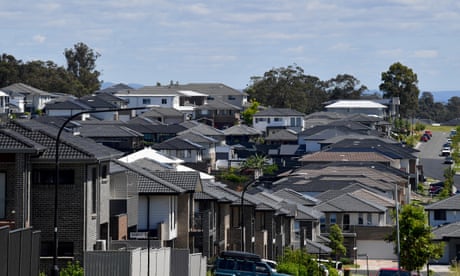- by foxnews
- 08 Apr 2025
Commonwealth rent assistance has no effect on Australia’s housing affordability, Anglicare says
Commonwealth rent assistance has no effect on Australia’s housing affordability, Anglicare says
- by theguardian
- 09 May 2023
- in news

An increase in commonwealth rent assistance has been mooted as a budget measure to ease the housing crisis for those on lower incomes, but Anglicare Australia has warned the payment is not "fit for purpose" and has no effect on affordability.
As a result of the way the payment is designed, rental assistance payments for nearly 300,000 people may have fallen this year as a direct consequence of the cost of living going up.
"This payment isn't really fit for purpose," said Anglicare Australia's chief executive Kasy Chambers. "Things have changed since it came in. It's not doing what it's designed to do. We're spending more and more on it, but it's not having any effect on affordability."
About 1.5 million low-income earners whose rent is above a certain level are entitled to commonwealth rent assistance (CRA). That minimum rent level, known as the "cut-in" rate, is adjusted twice a year to account for changes in the cost of living. The latest increase, in March, took it from $135.40 a fortnight to $140.40 for a single person with no children. CRA pays 75c in the dollar only for the amount of rent paid above that level, up to a maximum now set at $350 a fortnight (up from $337.54 in March).
The people most likely to find their payments reduced by indexation are those who receive a partial CRA payment - those whose rent does not reach the maximum amount. At the end of December 2022, there were 296,470 people in that position.
Before March, someone paying $300 a fortnight in rent was eligible for $123.45 in CRA (75% of the difference between $135.40 and $300), but after the cut-in rate went up that fell to $119.70 (75% of the difference between $140.40 and $300).
In a report on CRA in January, Anglicare found that the way the cut-in rate worked resulted in greatly reduced access to the payment, making it inequitable for people on lower incomes, and "the indexation of the payment and these thresholds means this inequity is maintained year on year".
Anglicare found a single person on youth allowance would need to spend a third of their income on rent - pushing them into rental stress - before they became eligible for CRA. Someone on the more generous age pension, however, would be able to receive assistance after only spending 14% of their income on rent.
Kristin O'Connell of the Antipoverty Centre also criticised the way the CRA worked.
"When we talk about inequity, there's a book to be written on rent assistance," she said.
"If you have the 'good fortune' to be paying enough rent that you can qualify for rent assistance, every time the indexation comes around you lose a little bit of that payment. Until you have the 'good fortune' to be paying so much rent that you're above the maximum."
Services Australia and the Department of Social Services would not say how many CRA recipients had their payments reduced as a consequence of the CPI increase, saying the data was not readily available.
A spokesperson from the Department of Social Services said CRA recipients "generally get more rent assistance over time as rents increase", which was "demonstrated by increases in average and median amounts CRA recipients have received over time".
The Anglicare report noted that only one in three people on jobseeker and one in 10 on youth allowance were eligible for CRA, and only one in four people on income support payments received it.
CRA is also badly designed for those in share-houses, the report found, as it requires all recipients to be on the lease agreement and cuts out when rent is more than $280 a fortnight - about $20 less than the rent for the average share-house room in a major Australian city, excluding bills.
The report argued that advocacy on CRA should focus on expanding access to support - for example, removing the cut-in rate - not simply raising the amount available for those who are already eligible.
But Chambers said Anglicare's primary concern was the inadequacy of welfare payments.
The treasurer, Jim Chalmers, has promised cost-of-living relief in the budget, and has come under pressure from Labor backbenchers, other politicians, advocates, academics, business leaders and its own economic inclusion committee to increase the rate of jobseeker across the board.
Chambers said she was concerned that the government might consider raising CRA "as a proxy way to raise jobseeker", even though CRA does not help the vast majority of people on welfare payments or address "the fundamental issue that those [welfare] payments are too little".
"It's an inadequate way to address the poverty situation because it isn't raising anyone out of rental stress," Chambers said. "We've never spent more on CRA and yet housing has never been more unaffordable."
The Anti-Poverty Centre wants to see jobseeker rates raised to the Henderson poverty line of $88 a day.
"Giving people an adequate welfare payment will alleviate all of these problems that we're facing in our lives at a time when you're most in need of having less stress," O'Connell said.
- by foxnews
- descember 09, 2016
Ancient settlement reveals remains of 1,800-year-old dog, baffling experts: 'Preserved quite well'
Archaeologists have recently unearthed the remarkably well-preserved remains of a dog from ancient Rome, shedding light on the widespread practice of ritual sacrifice in antiquity.
read more


